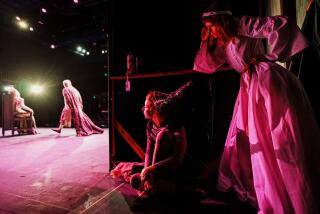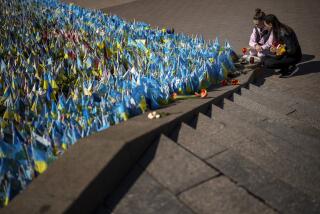Preservation With Progress Goal of Ukrainian Troupe
SAN FRANCISCO — “A folk dance brought right from the village would be too primitive to perform on the stage and too primitive for the spectators to follow,” says Miroslav Vantukh, director of the Virsky Ukrainian State Dance Company. “It would not be theatrical enough to give pleasure to the audience and people wouldn’t come to see it.”
At 49, Vantukh is younger than the company he directs, the company started in 1937 by the late Pavel Virsky, an acclaimed ballet dancer and choreographer from Odessa. Vantukh is its fourth artistic director/choreographer since Virsky’s death in 1975.
On its first visit to this country in 16 years, the Ukrainians will appear at the Pantages Theatre in Hollywood for seven performances, starting today. The 14-part program is made up mainly of reconstructions of Virsky choreographies, many of which were seen here during previous tours.
The exceptions are two works created by Vantukh, who says his main mission is the preservation of the choreographic creations and the high-technical standards set by the man he calls, “the great choreographic maestro Virsky.” Also, he adds, “to go on developing that work.”
“That is why, when I am choreographing my new numbers I always have to stop and think whether my works will fit into the whole manner of dancing that was established by Mr. Virsky,” Vantukh says.
One of his proudest moments, he says, came when Igor Moiseyev, director of the Moiseyev Dance Company, watched a rehearsal of the Ukrainian ensemble and later told Vantukh, “Miroslav, if Pasha (a Russian nickname for Pavel) Virsky were alive, he would come and thank you for the work you are doing and for what you are preserving of his work.”
But, Vantukh says, preservation does not mean standing still: “If we don’t move forward, the company is going to turn into a museum. It’s not going to follow the pace of life and it will wither and die. If it does not develop, the public will lose interest and will not come see it.”
Among the developments affecting the Ukrainian company are the new training methods being used in the East and West to produce dancers of greater technical prowess.
Speedy footwork, high leaps and aggressive athleticism have always been among the hallmarks of Ukrainian folk dancing, but the 83-dancer Virsky troupe takes those traits to the extreme.
The company’s dancers all began their studies with the same training as the dancers who later join the major Soviet ballet companies.
“Because,” Vantukh says, “just as air is important and necessary for the lungs, classical training is important for a dancer.”
But, he says, the company’s school also includes such additional classes as gymnastics for the women and acrobatics for the men, “to help in performing our breathtaking feats.”
The combination of classical ballet technique with the cultural traditions of the various Ukrainian regions was one of the principles upon which Virsky founded the company. The highly polished presentational style and the expressiveness of the folkloric material are not at all in conflict with each other, Vantukh says.
“To avoid that conflict, a choreographer has to be very subtle and know the point at which the two can merge. It has to be folk dance, but performed on a high professional level. If the choreographer fails at that, it will be neither.”
Vantukh, in the United States for the first time, says he is pleased with the way American audiences have received his company’s interpretation of Ukrainian dance, but not at all surprised by it.
“The art of choreography,” he says, “is based on gesture and beauty and there is no language barrier.”
More to Read
The biggest entertainment stories
Get our big stories about Hollywood, film, television, music, arts, culture and more right in your inbox as soon as they publish.
You may occasionally receive promotional content from the Los Angeles Times.










